Tube processing inside your DAW?
Lately, there has been some music industry product manager types ranting and raving on how there is very little innovation going on in certain segments of the trade and how most new products get whittled down to the lowest common denominator. Although, it’s hard to dispute when, yet another, cookie-cutter DJ mixer gets trotted out under the marketing hype of “game changer,” we have to disagree with this premise. Truth is, there is a ton of innovation going on, and the best part is that it’s not confined to the typical bluechip companies, it’s coming from every area of the globe. So when Mikael Dahlgaard reached out to us from Denmark about a new product from freqport that claimed to allow real vacuum tubes to act as a DAW plug-in, we were more than intrigued. We immediately set up a long-term review with three different reviewers who are familiar with tube processing and own several high-end tube processors – they’re comments in quotes below.
Freqport, a partnership between two small entities in Denmark and Australia, pitches the FT-1 freqtube, their only product, as “real analog processing inside your computer.” Quite enticing. Warming up your drum machines, synths, bass lines and more is something that every musician who works “in the box” can get behind. The concept isn’t completely new, Access was the first to bridge the gap between the hardware and software worlds with their Ti series of synths, then came Elektron’s Analog Heat and McDSP’s APB (Analog Processing Box). Elektron and McDSP still support their products, which take considerable effort to keep up with ever-evolving technology advancements, while the braintrust behind Access abandoned their products (and users! -Ed.) and started Kemper. This is certainly a consideration when evaluating if the freqtube is right for you, and can only be used as a plug-in in concert with a Digital Audio Workstation (DAW).
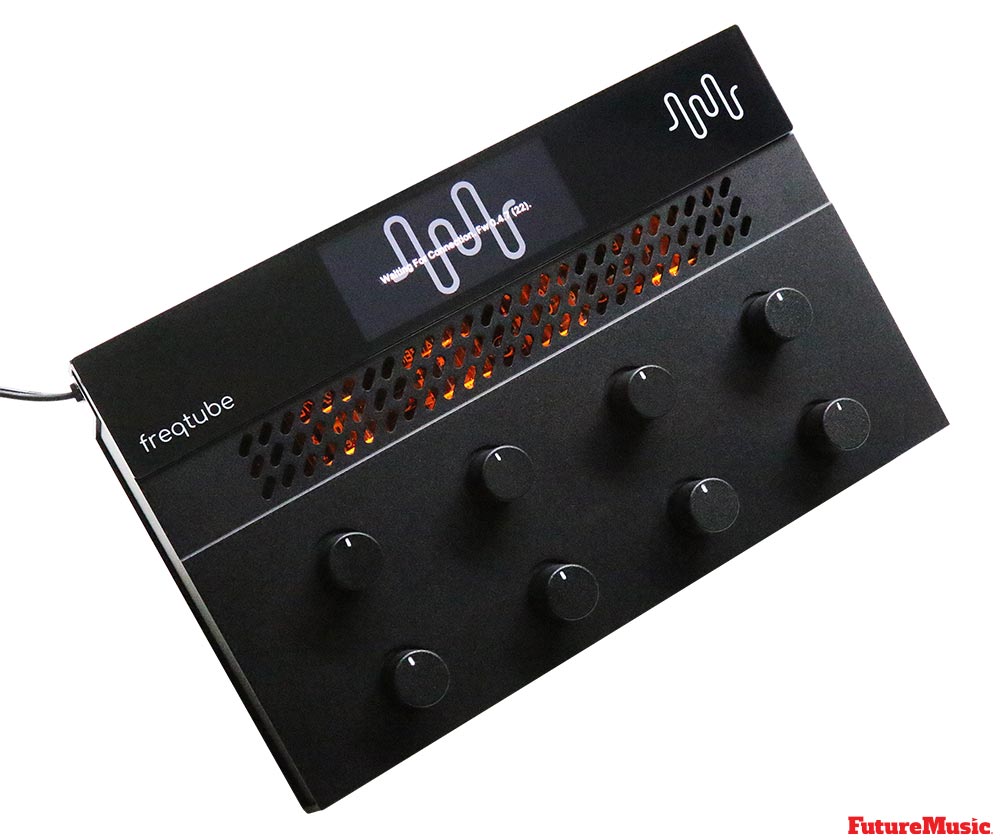

For a limited time only! Up to 80% off all Waves Bundles. PLUS click the banner above or the Go button for an additional 10%! This is Waves best deal yet! Get yours today before this special ends! Go!
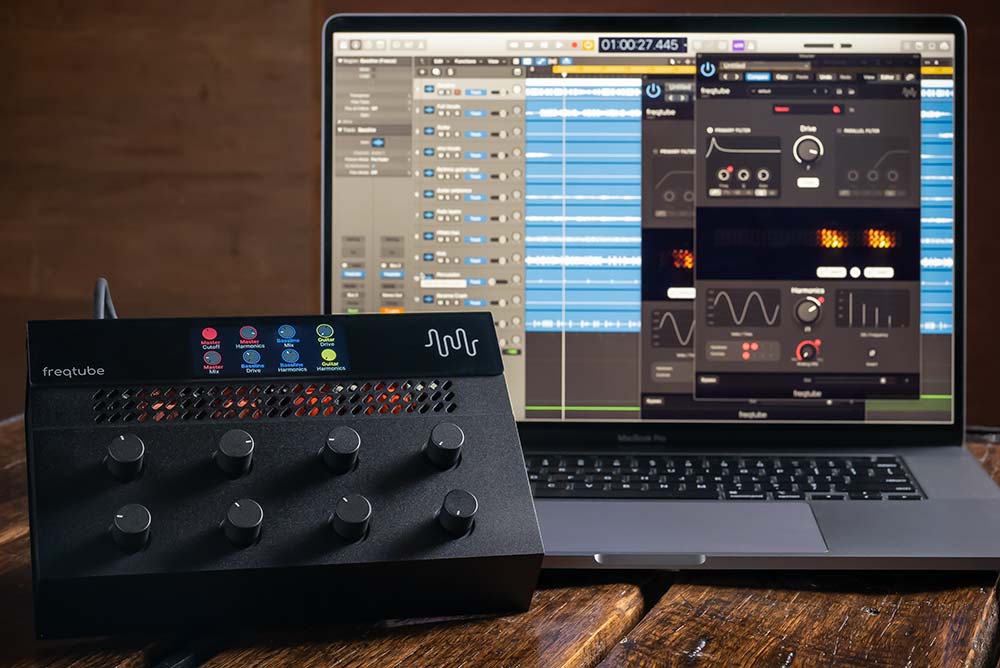
The freqtube ecosystem contains three elements, the hardware, the software plug-in and the middleware that marries the two. The hardware chassis that contains the four tubes is constructed out of black, anodized aluminum and features two rows of four knobs and a color LED screen. The build quality is first class and the unit feels “substantial” when you’re embracing it. The I/O consists of a single USB-C connection from the hardware to a Mac or PC. There are no analog inputs/outputs and no digital input/outputs. The “small power switch is crammed directly above the power connection” and can take a moment to locate.
Four Real Tubes
The tubes include two factory matched, high-gain E83CC (ECC83/12AX7) and two matched mid-gain ECC81 (12AT7) units, but their origin story is deliberately not revealed on freqport’s website and they are apparently not user replaceable. LEDs illuminate the tubes from below to simulate that warm tube glow. Considering the architecture, the tubes are powered in starved plate mode and not at their rated voltage, limiting some of that overdrive sorcery. Of course, this and the fact that there are no analog inputs will put off tube purists, but obviously compromises had to be made. Unfortunately, some of these compromises affect the sonic quality, but more on that later.

The freqtube’s plug-in interface showcases the four tubes
During our long-term review, freqport continually updated the software and firmware of the freqtube. In fact, our review was completely finished, but at the last-minute request of Dahlgaard, who had yet another firmware update up his sleeve, we started the process again. The firmware update did address some minor issues our reviewers encountered, but not others, which have a more profound affect on the user experience and sound quality. Knowing full well the blood, sweat and tears small manufacturers have to go through to get their products to market, we played along, but we had to put hundreds of hours into this review and we certainly feel the pain that early adopters had to face when dealing with a clearly unrefined product.

Despite the many challenges Freqport faced, they managed to deliver on their promise of “real analog processing inside your computer.”
When we started the review, Freqport didn’t have a set of authorized Digital Audio Workstations that were officially supported. Requirements specified that it was supported on both the Mac (Intel and Apple chips) and Windows. The Mac supports the VST3, AU, AAX plug-in flavors, while Windows supports, VST3. It was more of Your Mileage May Vary. Sure that’s fine for a publication reviewing the product, but not for the consumer. As the firmware updates rolled out, freqtube listed Ableton and Logic, then Cubase, ProTools and StudioOne as working environments. It does not work with Adobe Audition, which isn’t a surprise. Out of all the DAWs we tested, the freqtube plays best with Ableton Live. It does work under Apple’s Logic Pro, but can be finicky to setup. It also can take a few attempts to load once you have Logic open, since Apple wants to identify it as a sound card at the system level. The mysterious middleware, freqport Hub, can also cause issues on Macs, if it’s not loaded correctly in the background, or you launch the freqtube once Logic has been running for some time. It’s more like a stumbling forward approach, but with repeated attempts, it falls into place. ProTools was the least cooperative in our testing and experienced more latency than the other DAWs. (The latest firmware release has cleaned up much of the mess. —Ed.) The good news is that once you have everything working the plug-in stays stable, and you can let the freqport work its magic.
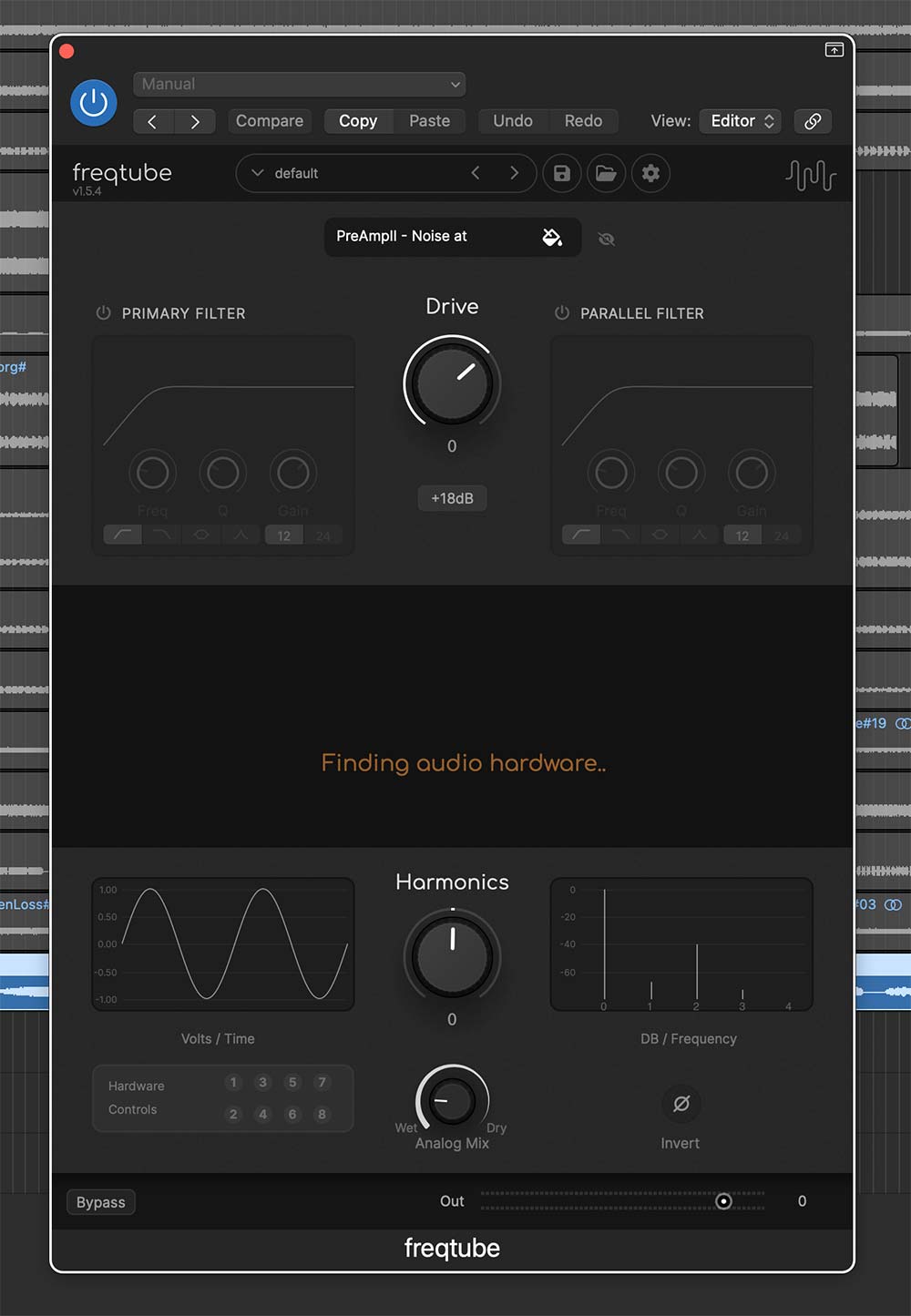
The freqtube can be a bit finicky to load

The rear view of the FT-1 freqtube
The unit can process audio as a stereo pair or dual mono. You can load two instances of the plug-in in one project in order to utilize the tubes separately, but our evaluators would often fine tune the freqtube and then bounce, or freeze the tracks and start again. Freqport doesn’t specify the D/A A/D convertors employed in the freqtube beyond that the A/D is 116dB DNR 32bit and the D/A is 120dB DNR 32bit with up to a 192kHz sample rate, but they performed the heavy-lifting necessary and “didn’t exhibit problematic artifacts” that are apparent in poor quality units.
The freqtube can be controlled via the eight rotary knobs, or via the plug-in interface. Having the knobs is an interesting choice, and would make more sense if the unit had analog inputs/outputs, but freqport probably could have eliminated them, as well as the color LED screen. However, after spending considerable time with the unit, we’re glad that they made it into the final spec — more on that below. Our evaluators did like how the current setting was indicated by a tick on the visual depiction of the knob and the knob only “activated” once it hit that tick, turning the knob from gray to color. A savvy graphical design choice that more manufacturers should implement.
Freqport FT-1 freqtube Specifications:
- Two Factory matched, high-gain E83CC (ECC83/12AX7) and two matched mid-gain ECC81 (E81CC/12AT7) tubes
- Power: 24W DC power adaptor / 100Vac – 240Vac. 50/60Hz. – Cannot be bus powered
- Ambient Temperature Range: 0° to 50°C
- USB Type-C Connectivity
- Unspecified ESS Converters: 120dB DNR 32bit D/A/C / 116dB DNR 32bit A/D/C up to 192 kHz
- Dimensions: 205mm x 130mm x 50mm (W x H x D)
- Weight: 810g
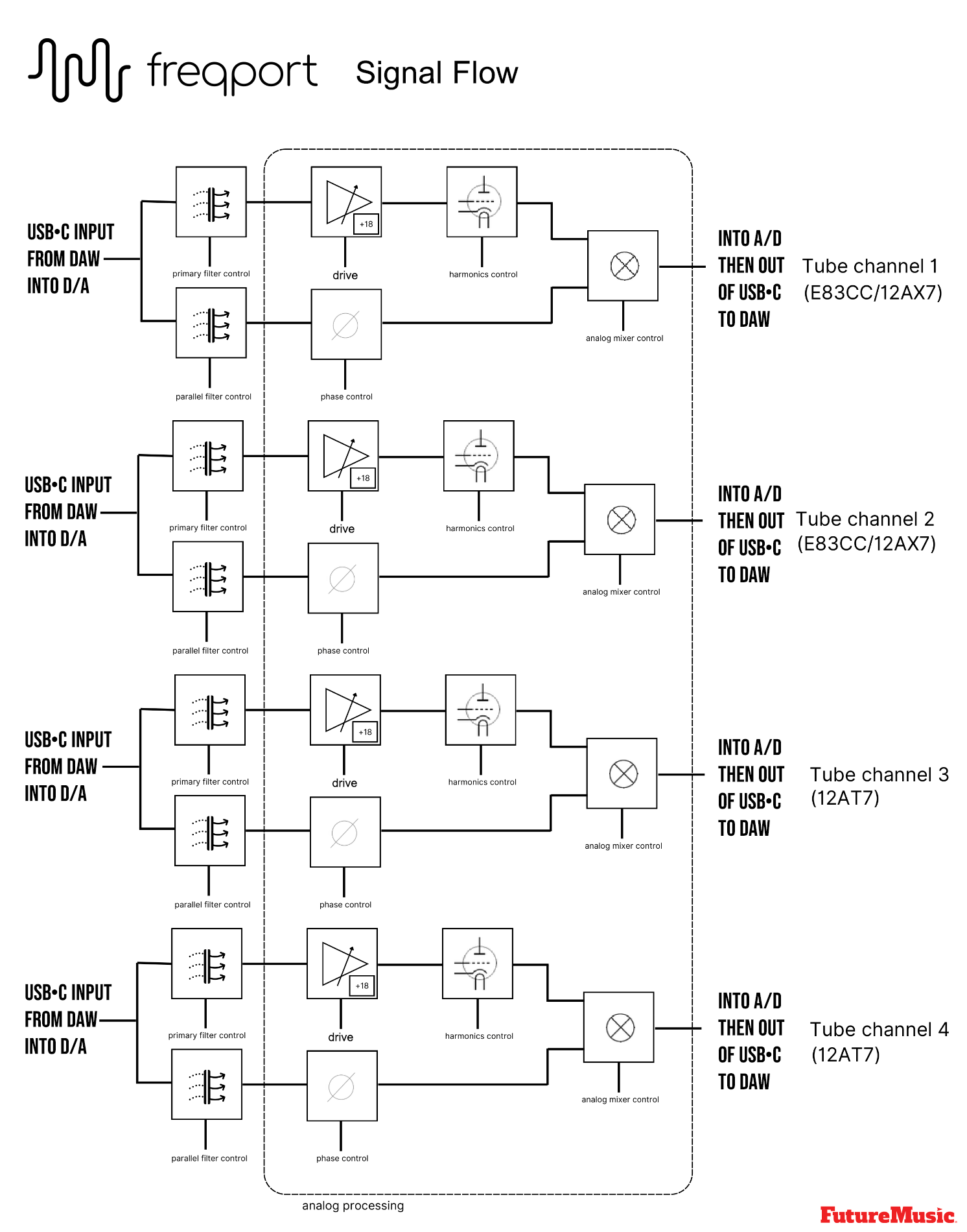
Unlike other tube emulators, the freqtube’s uses its own unique signal path. The digital signal arrives from the USB-C connection from the DAW and is immediately split between the primary digital filter and the parallel digital filter controls. The parallel filter is based on an unspecified “hardware based model” and has frequency, Q and Gain controls, as well as 12 or 24 filter types, high pass, low pass, peak or bandpass. This “Dry” signal does not interact with the tubes and then is sent to a Phase Invert before being mixed back into the output.
The other split is routed to a Primary Filter with the same controls and then into a Drive control with an extra +18 dB. It’s a way of digitally shoving the starved tubes into that delicious overdrive tone, but you have to be careful. During the first round of testing, the Drive would start clipping the signal prior to truly overdriving the tubes, which is obviously not the effect users desire. During the second round of testing, after the latest firmware/software update, freqport managed to dial up additional headroom, which helped to mitigate this issue – to an extent.

The easiest way for electronic musicians to get their music onto Spotify, Apple Music, iTunes, Amazon Music, Tidal, Instagram, Facebook, TikTok, Pandora, Twitch & much more! Click the banner above or the Go Button to save 7% off of your signup! Go!

In the tube section, you can select the E83CC’s or the 12AT7’s either dual mono or stereo. Next, the signal routes into the Harmonics section, a One-Knob affair flanked by two visual graphs of the Volts/Time and dB/Frequency. Finally, it lands into the Mixer Output where the non-tube signal (Dry) can be incorporated. You can choose to utilize either of the filters, or simply turn them off and send the signal directly into the tubes on the one side and the phase control on the other.
All in all, it gives you discreet ways to shape your overall tone and artificially overdrive the tubes. It “works great” on electronic music and hip-hop productions where many of the elements are inherently digital. In fact, Dubstep, Drum ‘n’ Bass, Techno and some Trap can all significantly benefit from harnessing the harmonics of the tubes, but other “tone-philes may not be as impressed.” It “simply comes down to being able to punish the tubes with current, as opposed to digital tricks.” Guitar/bass tone aficionados will certainly opt for aptly powered processors with additional methodologies for manhandling the second/third harmonic structure, but that comes at a significant increase in cost and is really not what the freqport is designed to achieve.
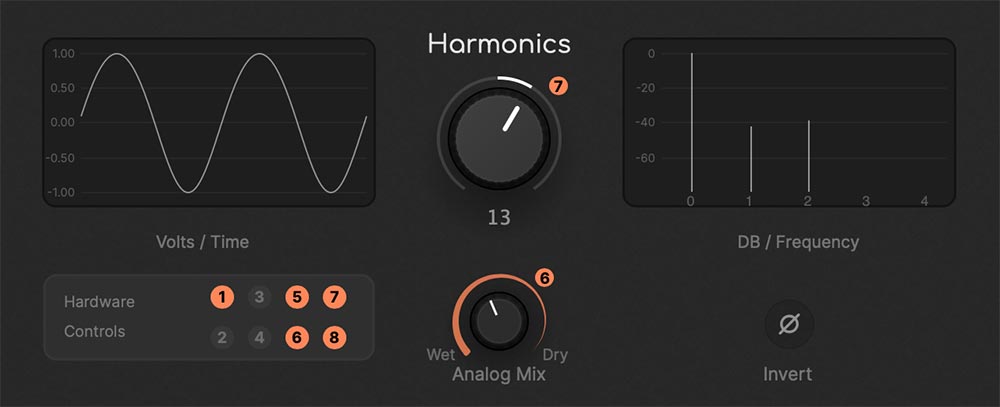
One feature that gives the freqtube a distinct advantage in your workflow over other tube-based gear is being able to save your own custom presets for instant recall. Unlike dedicated outboard gear, you can develop your own suite of presets for specific applications. Each preset can also have its own designated color, seven are available, for personal identification. The plug-in interface also has an eye icon to the right of the preset selector. By default, it’s off, but turning it on displays each preset’s routing. All of our evaluators left it on while testing. The freqtube only comes with nine presets, which are nice starting points, however, all of our reviewers ended up creating their own preset packs. “Having your own presets at your immediate disposal is a big advantage that hardware can’t match.”
Another aspect that our testers found befuddling was the choice for freqport not to allow users to change the signal flow. You simply can’t put the Primary Filter after the tube stage or make any other changes beside turning stages on or off. That said, freqtube does allow you to custom assign the units knobs. Want to assign one of the knobs to the filter cutoff? Simply, hit a Hardware Controls’ numbered button not in use on the plug-in and then manipulate the filter. It’s automatically assigned and you can now use that to tweak the parameters on the fly or record in your automations. Again, for electronic music, this can add nice movement and texture to your bass lines, leads, high-hats and anything else you want to add some variety and texture.

If it wasn’t painfully obvious at this point, the freqtube is not intended for punishing effects. It takes a more gentle and delicate approach. Sure you can add some grit to the sound, but that’s more about the digital processing than “cooking the tubes.” Because of the underpowered nature, many users won’t find a serious difference in the two tube types, but our evaluators found the 12AT7 side to work nicely as a harmonic vitalizer on low settings, while employing the E83CC for more aggression. Techno artists will love what the freqtube can do to create banging kick drums with tons of thump in a combination with the filters, “it sounds amazing on 909 and 808 kicks.”
Finally, the Harmonics stage is where things can get interesting, weird and sometimes ugly. The 12 o’clock position is essentially neutral, but going below 10 o’clock or above 2 o’clock sends the freqtube into Flat Earth realms. The signal will either breakup, disappear or yank the stereo image way to one side, an artifact of exceeding the tube’s thresholds. In some occurrences, the signal breakdown can be useful for Glitch, Industrial or Experimental beats, but “it mostly sounds like a garbage disposal.” The stereo imaging can be an issue, especially if you’ve dialed in something that you really like, but you can easily find workarounds. For electronic musicians, we found that tweaking the Filter with the Harmonics can result in some dynamic sweeps – great for transitions and breakdowns.
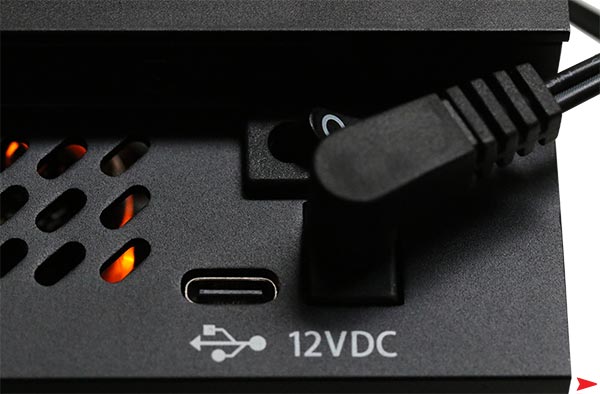
The small power switch is “crammed” under the hood next to the power input and USB-C connection.
Conclusion
The freqtube is an innovative product that breaks new ground in getting real tube action inside your DAW. In some ways, the product is still ramping up to speed and has a few shortcomings, but in our long-term test we’ve seen freqport make solid advancements with each firmware/software release. You do run the risk that if freqport disappears, your freqtube will not be supported and will end up like that tattoo you regret — a permanent reminder of a bad decision. That said, for under a grand, it’s definitely a wager you should take — unlike that Flying Skateboard you invested in on Kickstarter. Highly Recommended.
Freqport FT-1 Freqtube Rating: 90%
Cheers:
+ Build Quality
+ Sound Quality
+ Low Noise
+ Low Latency
+ Solid Value (as long as it’s supported)
+ Preset Recall
+ Automation
+ Can Be Played Live
+ Excellent For Electronic Music
Jeers:
– Wafer Thin Manual
– Power Button Position
– Can Be Finicky To Launch
– No Analog I/O
– Can’t Change Stage Positions
– Firmware Not 100%…yet
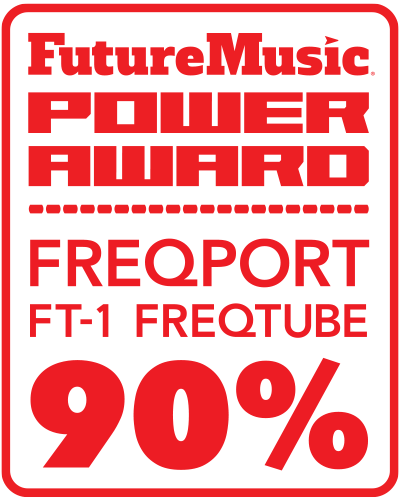
Freqport’s FT-1 freqtube costs $999 and is available now.
The Future: Delivering “real analog processing inside your computer” is no easy task, and while the freqtube isn’t without its issues, it does achieve its goal, even if it needed to be dragged kicking and screaming across the finish line. While freqport does still face several challenges getting their software / firmware to work in perfect harmony inside of most DAWs, if they do consider a sequel, we have a couple of suggestions. First, we’d love to see analog I/O so that the freqtube could be used as a standalone unit to provide some gentle tube love to synths and other electronic instruments. For the plug-in, we’d also like to see additional harmonic options, as well as a routing matrix to change the order of the stages.






